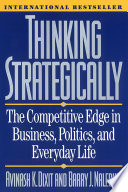

Strategic thinking is the process of considering the long-term consequences of decisions and actions. It involves analyzing situations, anticipating future developments, and making informed choices that align with broader objectives. The authors emphasize that strategic thinking is not just for leaders but is a critical skill for anyone in a competitive environment. By thinking strategically, individuals can better navigate complex situations, foresee potential challenges, and position themselves advantageously. The book illustrates this with examples from various fields, showing how strategic thinkers can outmaneuver opponents and achieve their goals.
Continue readingThe book delves into game theory, a mathematical framework for analyzing strategic interactions among rational agents. The authors explain key concepts such as Nash equilibrium, dominant strategies, and zero-sum games, illustrating how these principles apply to real-world scenarios in business and politics. By understanding game theory, readers can better predict the behavior of competitors and collaborators, enabling them to make more informed strategic decisions. The authors provide case studies that highlight how game theory can be used to devise winning strategies in various contexts, from negotiations to market competition.
Continue readingA central theme in the book is the importance of anticipating the actions of competitors. The authors argue that successful strategists not only focus on their own moves but also consider how their competitors might react. This involves analyzing the motivations and potential strategies of others, allowing for proactive rather than reactive decision-making. The book provides frameworks for assessing competitor behavior and developing strategies to counteract or leverage these actions. By mastering this skill, individuals and organizations can gain a significant advantage in competitive environments.
Continue readingCredibility and commitment are crucial components of strategic decision-making. The authors explain that a player's credibility can influence the actions of others, as it shapes perceptions and expectations. Committing to a particular course of action can serve as a strategic signal to competitors, potentially deterring them from certain moves. The book discusses how individuals can leverage credibility and commitment in negotiations and competitive scenarios, emphasizing that these elements can be as powerful as the actual resources or capabilities one possesses.
Continue readingStrategic moves are actions taken to influence the perceptions and decisions of others. The authors highlight the importance of signaling in strategic interactions, where one party communicates intentions or capabilities to another. This can involve both overt actions and subtle cues. The book provides examples of how effective signaling can lead to favorable outcomes in negotiations and competitive situations, illustrating that understanding the dynamics of signaling can significantly enhance one's strategic effectiveness.
Continue readingInformation asymmetry occurs when one party in a transaction has more or better information than the other. The authors discuss how this imbalance can affect strategic interactions, leading to suboptimal outcomes for the less informed party. They explore strategies for managing information asymmetry, such as signaling and screening, and emphasize the importance of information gathering in strategic thinking. By understanding and addressing information asymmetries, individuals can improve their decision-making and negotiation outcomes.
Continue readingThe book contrasts long-term strategic planning with short-term tactical decisions. The authors argue that while immediate gains may be tempting, a focus on long-term objectives is essential for sustainable success. They provide frameworks for balancing short-term actions with long-term goals, emphasizing the importance of foresight and adaptability in strategic thinking. The book encourages readers to cultivate a long-term perspective, enabling them to make decisions that align with their overarching aspirations and values.
Continue reading